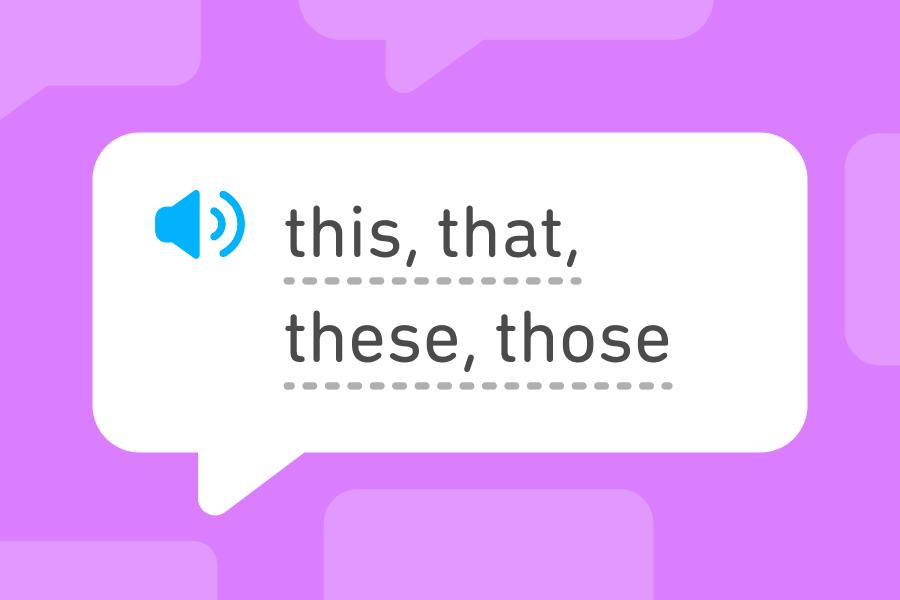When speaking or writing, you may find yourself needing to distinguish exactly which book, chair, house, cat or other noun you’re referring to. This is why demonstrative adjectives (this, that, these, and those) can be so helpful!
With four different forms to pick from, they can sometimes feel a little confusing. But with the guide below, you’ll be able to choose the right demonstrative adjective with confidence!
In this post
- What are demonstrative adjectives?
- How do you use demonstrative adjectives?
- What are demonstrative pronouns?
What are demonstrative adjectives in English?
Demonstrative adjectives, also called demonstrative determiners, are adjectives that give information about the relative distance of a noun in time or location.
In English, there are four demonstrative adjectives:
- this
- that
- these
- those
How do you use demonstrative adjectives?
Demonstrative adjectives always appear before the noun they’re referring to. However, they can be a little tricky because they change based on two factors:
1) Distance of the noun in time or space
For example:
DISTANCE SINGULAR PLURAL CLOSE This coat is too small! These trees are beautiful. FAR That coat is too small! Those trees are beautiful.2) Number (singular or plural)
DISTANCE SINGULAR PLURAL CLOSE You can sit in this chair. Is she in that class too? FAR You can sit in these chairs. Is she in those classes too?Putting these two factors—distance and number—together, each demonstrative adjective has a specific use case:
DEMONSTRATIVE ADJECTIVE DESCRIPTION this singular, close that singular, far these plural, close those plural, farHow do I know if a noun is considered “close”?
Don’t worry, you don’t need to pull out a yardstick to know which demonstrative adjective to use! See the examples below to understand when to use close demonstrative adjectives (this, these) and when to use far demonstrative adjectives (that, those):
YOU SAY… I love this shirt! I love that shirt! IF… you’re holding or wearing the shirt you are talking about someone else’s shirt YOU SAY… This evening was amazing! That evening was amazing! IF… you are talking about today you are talking about an evening in the past YOU SAY… Please put this blanket on the bed. Please put that blanket on the bed. IF… you are holding the blanket the other person is holding the blanket YOU SAY… Junior went to school this morning. Junior went to school that morning. IF… you are talking about today you are talking about a day in the past YOU SAY… These cookies are delicious. Those cookies were delicious. IF… you are eating the cookies now you already ate the cookies YOU SAY… Do you know these kids over here? Do you know those kids over there? IF… the kids are playing close to you the kids are playing further away from youAdvanced English: other uses of demonstrative adjectives
In conversational English, demonstrative adjectives can also be used to highlight information or put emphasis on the noun.
For example, this and these can be used to introduce a new topic. If you're telling a friend a story about a person you met, you might say So I met this guy at the bookstore yesterday—even if the guy isn't close to you in time or space. It lets the listener know to pay attention because the guy is going to be the topic of this story!
Similarly, you can use that to refer to a shared memory you have with your friend. If you ask them Remember that guy I met at the bookstore last week?, you’re showing that you have previously talked about the guy in question.
Another way to use this and that is for contrast. You might point at some sweaters in a store and say I don’t like this sweater, but I like that one—even if both of them are right in front of you! In this case, the demonstrative adjectives are helping you make a distinction between the two sweaters.
What about demonstrative pronouns?
You will sometimes see the words this, that, these, and those not followed by a noun. When they are used this way, these words are called demonstrative pronouns. Demonstrative pronouns change for distance and number in the same way as demonstrative adjectives. In the examples below, this, that, these, and those are all being used as demonstrative pronouns:
This is my grandma, Lucy.That is a great idea!
I love these!
Those are too small.
You’ve learned a lot about these adjectives!
Demonstrative adjectives can be very useful for making it clear exactly which thing (or things!) you’re talking about. And while you might feel a little unsure at first whether you should use this demonstrative adjective or, well, that one, with a little bit of practice, you’ll be a demonstrative adjective expert in no time!
To learn more about adjectives, check out all of Duolingo's adjective guides:

 60+ descriptive adjectives in English
60+ descriptive adjectives in English